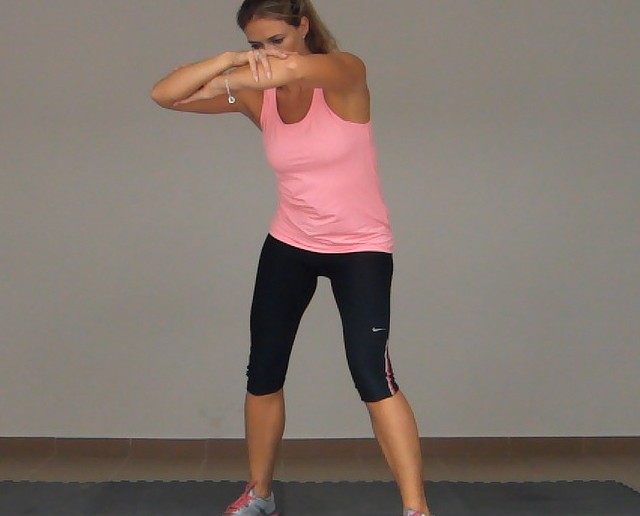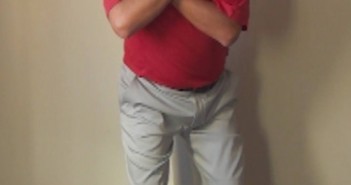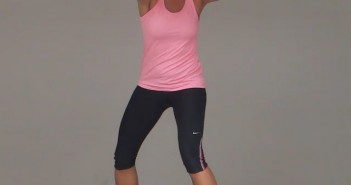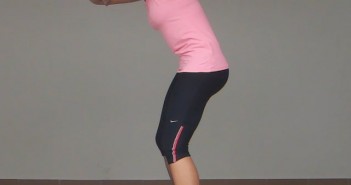The Pelvic Disassociation Exercise teaches you how to move your pelvis independently of your shoulders, helping you to both create and close the separation of your pelvis and shoulders for power and consistency in your golf swing.
The Pelvic Disassociation Exercise forms part of the Golf Mobility series of innovative and dynamic exercises that will help to improve your joint and muscle mobility, improving your range of motion while increasing functional strength within the entire range of that motion – thus helping to prevent injuries and building the foundation for a consistent, accurate, and powerful golf swing.
Figure 1. Pelvic Disassociation Exercise.
Steps
- Start by standing with the perfect stance width and spine angle. See Golf Swing Drill 102 – Setup: Perfect Golf Stance Width and Ball Position and Golf Swing Drill 103 – Setup: Perfect Golf Spine Angle. Don’t tilt your spine away from the target for this exercise.
- Stand with your arms folded in front of your chest.
- Without moving your shoulders or chest, slowly turn your pelvis and hips to the right.
- Return your pelvis to the midline, and repeat to the left.
- Repeat for the desired number of repetitions in each direction.
Make sure that you maintain perfect posture throughout this drill, keep your shoulders back, your back straight, and your abdominal muscles engaged.
Try this exercise in front of a mirror to make sure your shoulders and chest do not move as you turn your pelvis and hips.
Place your fingertips lightly on each shoulder so that you can feel when your shoulders try to move.
It’s okay if your knees move as they are pulled around by your hips, but don’t actively push with your legs.
The primary feeling should be of pulling your pelvis around with your obliques.
Concentrate on your core, especially your obliques, isolating the movements to your lower back, hips and pelvis.
How Will It Benefit Your Golf Swing?
The ability to separate your pelvis from your shoulders is crucial for a good golf swing, especially in the downswing.
This separation (the so-called X-factor) enables you to generate more power by stretching out the big muscles in your core as you coil your torso, and by generating lag in your swing through the compound pendulum effect.
If you can’t properly separate your pelvis from your shoulders, not only will you lose club head speed through impact, but you’ll rotate your whole body at the same time during your golf swing, causing a weak and destructive over-the-top or out-to-in swing path, often resulting in a horrible slice.
This pelvic disassociation exercise teaches you how to move your pelvis independently of your shoulders, helping you to both create and close the separation of your pelvis and shoulders for power and consistency.
For more information on the perfect golf posture, see Golf Swing 101 – Setup: Basic Posture and Golf Swing 103 – Setup: The Perfect Golf Spine Angle.
Target Muscles
This exercise mainly involves your internal obliques, external obliques, gluteus medius, piriformis and transversus abdominis.
If you have any questions or comments about this or other articles on Golf Loopy, please send us an email.
You May Also Like…
Golf Performance Programmes – the most effective golf-specific fitness regimens on the planet, guaranteed to make you a better golfer!
Introduction to the Swing like a Champion System.
Golf Swing 101 – Setup: Basic Posture.
Golf Swing 103 – Setup: The Perfect Golf Spine Angle.
Golf Anatomy and Kinesiology, a collection of articles describing the roles of the muscles involved in the golf swing.
Core muscles, which describes the muscles that run the length of your trunk and torso.
Oblique muscles, which describes in more detail your side abdominals, which help you to bend from the side or twist your torso, and their role in the golf swing.
There are a number of other golf-specific mobility exercises in the Golf Loopy Train like a Champion System.




